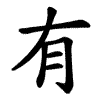有
- to have;
- to exist;
- to be present;
Extended uses include “possess,” “there is/are,” and in some classical contexts, “abundance” or “good harvest.”
Etymology
In Oracle bone script (甲骨文 jiǎgǔwén): written as 又 (hand), symbolizing grasping or holding.
Because 又 was later borrowed as the adverb “again,” an element of 肉 (meat/flesh) was added in bronze inscriptions (金文 jinwen) to clarify the sense of possession.
In Shuowen Jiezi: explained as 月 (moon) as semantic element + 又 (hand) as phonetic. However, modern research recognizes the original hand-based pictograph as “to hold, to have.”
Phono-semantic compound:
月 (moon, later seen as semantic radical in regular script; in reality, an evolved form from 肉/flesh).
又 (hand) – phonetic, originally pictographic of a hand.
Thus, 有 developed from “to grasp in the hand” to “to possess”, “to exist.”
Usage in Korean
有名 (유명) – famous (lit. “have a name”)
有力 (유력) – powerful, influential
有用 (유용) – useful
所有 (소유) – possession, ownership
存在有 (존재유) – to exist
Words that derived from 有
- 만유원력(萬有原力)–Universal prime energy
- 소유(所有)–ownership; possession
- 소유물(所有物)–possession; property
- 유(有)–existence
- 유기체(有機體)–organism; organic organization; organic body
- 유력(有力)–being strong; being rich
- 유리(有利)–being profitable; being beneficial
- 유무(有無)–existence and nonexistence
- 유수(有數)–being prominent; being distinguished
- 유신론(有神論)–theism
- 유형(有形)–tangibility
- 유효(有效)–being valid
- 점유(占有)–occupation
- 향유(享有)–enjoyment; possession
Additional notes
冇 (“not have”) is a related character, used in Cantonese (pronounced mou). Not found in Kangxi Zidian, but encoded in Unicode under the 冂 radical.
In Book of Changes (周易) and other classical texts, 有 could also mean “abundance” or “good harvest.”
Modern radical classification places 有 under 月, though historically the component was 肉.
